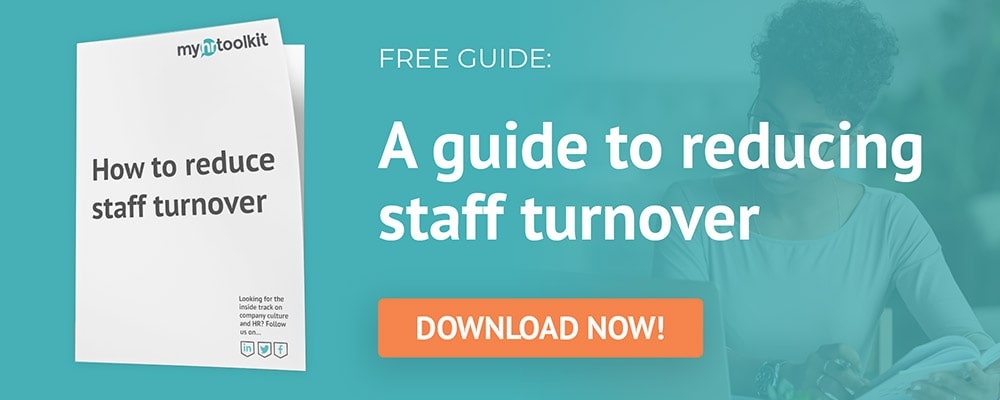What is the 'Great Resignation' and how is it going to impact small businesses? HR professional Gemma Dale FCIPD outlines the factors behind the phenomenon, how SMEs can respond to it, and tips for retaining employees who may be looking for jobs elsewhere.
To learn more about what employers and managers can do to respond effectively to the Great Resignation, make sure to watch Gemma Dale's webinar with myhrtoolkit:
The term ‘the great resignation’ was first coined in May 2021 by US professor of management Anthony Klotz. He predicted that after the pandemic we would see a wave of employees leaving their current roles for pastures new. Surveys seem to suggest the prediction may be a sound one; one UK survey in particular found that in late 2021, as many as 1 in 4 in employees were thinking about looking for a new job.
Are people really quitting?
In the US at least, it seems like the phenomenon may have some accuracy; between April and September 2021, turnover reached record levels. Of course, within that data are significant differences across regions, role types, employee age, and levels of seniority. Research from Microsoft suggests that globally, up to 40% of the workforce are considering leaving their job – but only time will tell if the ‘great resignation’ will truly occur, and to what extent.
What’s driving resignations?

There are several reasons why people may currently be leaving their employer – or at least thinking about doing so. The great resignation is not about one single issue – it’s a mix of complicated and interrelated factors.
Delayed turnover
First of all, there are those employees that might have left their employer for a whole range of reasons but, given the unpredictable nature of the pandemic, stayed put in their current role longer than they might otherwise have. This isn’t so much new turnover as it is delayed. Within this group, the reasons for leaving are likely to be those with which we are already familiar: more money, better career prospects, or changes in personal circumstances.
The desire for flexibility
As a result of the so-called ‘great homeworking experiment’ that has taken place during the pandemic, employee demand for more flexible working arrangements has increased significantly – especially the desire to work from home or in a hybrid way. Although many employers have responded positively to this emerging preference, this is by no means universal. As a result, some employees have been clear: if they can’t get flexible work at their current employer, they will be prepared to seek it elsewhere.
Pandemic epiphanies
Finally, there is another important category of which organisations should be especially mindful: those employees that are seeking a profound change. The pandemic has been a complex and difficult time for many people. Employees may have experienced bereavement, ill-health of themselves or their loved ones, or burnout from changed or increased work requirements.
Living through such experiences can lead to the desire for something new, or a changed purpose or motivations. This too may lead people to seek a different sort of job or employer. Klotz calls these ‘pandemic epiphanies’. The provision of a little more flexible working may not provide the change these individuals crave. CIPD Chief Executive Peter Cheese has suggested this is more of a ‘great rethink’ than a great resignation.
What should employers do to stop a great resignation?
Employers need to understand why people are leaving – and why they stay. First of all, start with understanding the data: organisations should ascertain their current turnover figures and compare them with previous trends to identify any changes. Look not only at the headlines of total turnover, but consider who is leaving, what roles are they in, and factors such as their gender, age, disability status, and race.
Exit and stay interviews
The next data step is to understand where they are going to, and what their key reasons for leaving are. Exit interviews can be a key source of information, so where problems are identified, be sure to conduct these in person rather than relying on standard forms.
Organisations may also want to engage not just with leavers but current employees. The ‘stay interview’ is the opposite of an exit interview. Ideally an informal conversation between employee and their manager, it aims to explore what people like about their role, what motivates them, and why they choose to stay with their employer. Stay interviews can give valuable insight – and help to identify employees who might be at risk of leaving in the future. These two rich sources of data can be used to develop a tailored action plan to avoid the potential of a great resignation.
Retention strategies
Organisations also need to think about retention strategies; taking deliberate action to engage and retain employees, especially during this time of continued challenge and change. Providing more flexible and remote work options is now a critical part of the employee value proposition; those employers who are still considering how to do this can find more information in my 10 step action plan for hybrid work.
Of course, there is more to employee retention than providing flexible work. Employers also need to consider how to provide career development opportunities, support employee wellbeing (especially in relation to the ongoing health implications of the pandemic), and support employees to reconnect socially with colleagues – something that we know supports engagement at work.
These actions can help to turn a potential great resignation into a great retention!
Read more from the myhrtoolkit blog

Written by Gemma Dale
Gemma Dale is an experienced senior HR professional, CIPD Chartered Fellow, HEA Fellow, and a regular speaker and writer on a variety of HR topics. Gemma is the co-author of the book 'Flexible Working' published by Kogan Page in 2020. She is also a lecturer in the Business School at Liverpool John Moores University and runs her own business, The Work Consultancy.


 Holiday Planner
Holiday Planner Absence Management
Absence Management Performance Management
Performance Management Staff Management
Staff Management Document Management
Document Management Reporting
Reporting Health and Safety Management
Health and Safety Management Task Management
Task Management Security Centre
Security Centre Self Service
Self Service Mobile
Mobile
-1.png?width=760&name=Webinar%20CTA%20(recording)-1.png)




